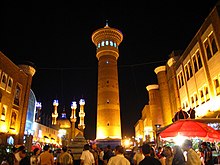
Guilin (桂林) was China’s first city to develop tourism after 1949. For decades, children’s textbooks proclaimed ‘Guilin’s landscape is the best under heaven’ (桂林山水甲天下). It was the darling of Chinese politicians, the star city proudly presented to visiting dignitaries. Today Guilin’s natural endowments still amaze, yet, thanks to imperfect urban planning, there is a pervasive feeling that the city is past its prime. It relies mainly on tourism to boost the local economy, so the entrance tickets to various attractions are quite high in my opinion.

Just 2h 45min by high speed train from Guangzhou, you would have arrived in the third largest city in Guangxi province. Guilin is a beautiful city. The town center is surrounded by two rivers and four lakes and studded with sheer sided karst mountains. Outside the city center, the buildings are less maintained. The main industry in the city is tourism so the city is much cleaner than other Chinese cities. When we visited in March, there was a cold spell in the city so the average temperature in the city was 15-18 degrees. It brought a cool respite to our hot days in Singapore and we enjoyed this kind of refreshing weather. However, the locals lamented that they were actually looking forward to spring and warmer weather.

Guilin itself is like most other medium size Chinese cities, other than that it has a large number of western-style hotels, tourists and is relatively free of air pollution. Many Chinese domestic tourists also flock to this area. What makes it special is its proximity to many picturesque limestone mountains and formations.

It is possible to cover the city within a day, leaving your remaining days for day trips to the surrounding region, such as the Longji rice terraces and Yangshuo. The city looks different during the day and at night. It is beautifully illuminated at night when the multicoloured lights shine on the limestone structures, bringing out their inner beauty.


Elegantly embellishing the scenery of Shan Lake, the Sun and Moon Twin Pagodas, beautifully illuminated at night, are the highlight of a stroll around Guilin’s two central lakes. The octagonal, seven-storey Moon Pagoda is connected by an underwater tunnel to the 41m-high Sun Pagoda, one of the few pagodas with a lift. I did not have a chance to enter the pagodas, but viewed it from a distance instead. Anyway, a local told us that it is not worth it to go inside the pagoda as the entrance fee is quite steep and there are a few relics inside only.

At the southern end of Guilin where the Li River and the Taohua River converge, one of Guilin’s best-promoted sights is Elephant Hill Park, where Elephant Trunk Hill – unlike other misshapen lumps of rock with tenuous names extracted from Chinese myth – indeed it resembles the trunk of an elephant dipping into the river. . Visit Water Moon Cave and head up the peak walk to Puxian Pagoda for views of the park and the picturesque Li River.

Reed Flute Cave is located about 5km west of Guilin. This limestone cave contains impressive stalactite and stalagmite formations and is worth a visit only if you have not seen such caves before. There are various artificially lit formations supposedly resembling lions, monkeys, old men, the skyline of Guilin, etc. inside the cave. There is also a brief laser/light/music show which spoils the atmospere. The entrance to the cave costs ¥120 and pictures of the cave are plastered over Guilin city in a bid to attract more tourists to visit.

Zhengyang Pedestrian Street is the new landmark of Guilin. It is “the first commercial shopping street in western China” This street is 666 meters long and surrounded by restaurants, hotels, theatres, stadiums, commercial facilities and scenic spots.
With its central location, Zhengyang Pedestrian Street is easily to access through various ways and also a place to catch up with friends over food or drinks.


As you can see, there are not many sights around Guilin. I will suggest two day trips out of the city in subsequent posts.



